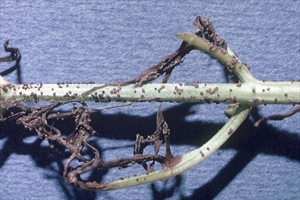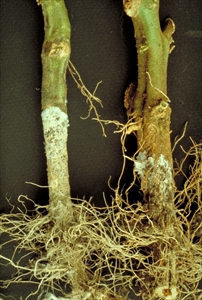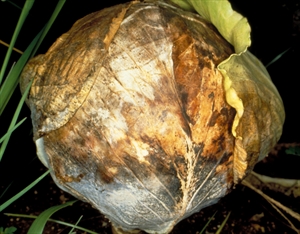Leaf blight, seedling blight, stem canker, sheath blight, web blight. Usually, the common name is followed by the host, e.g., web blight (of beans), sheath blight (of rice).
Pacific Pests, Pathogens, Weeds & Pesticides - Online edition
Pacific Pests, Pathogens, Weeds & Pesticides
Cabbage Rhizoctonia web blight (126)
Thanatephorus cucumeris and Ceratobasidium cornigerum are the name of the sexual states, whereas the asexual states are placed in the genera Rhizoctonia and Ceratorhiza, respectively. In this fact sheet, the pathogen is called Rhizoctonia.
Asia, Africa, North America, South and Central America, Europe, Oceania. It is present in American Samoa, Australia, Federated States of Micronesia. Fiji, French Polynesia, Marshall Islands, New Caledonia, Palau, Papua New Guinea, Samoa, Solomon Islands, Tonga, and Vanuatu.
More than 30 plant families are hosts, e.g., many vegetable species (cabbage and other members of the cabbage (brassica) family, carrot, legumes, potato, tomato), and weeds.
Rhizoctonia is a fast growing fungus that does not normally produce spores, although it does produce tight balls of fungal growth called 'sclerotia', mostly 0.5-1 mm diameter, but occasionally up to 5 mm (Photos 1&2). The sclerotia are survival structures of the fungus, staying alive in the soil for many years. During rain, they are splashed onto stems and leaves where they germinate. The fungal growth that develops rots the leaves and often binds them together. Stems are also attacked, as are the root systems of many vegetable species (Photo 3).
The fungus can survive in the soil, living on dead and dying plant remains, and on weeds. Spread of the fungus occurs in soil water, contaminated tools and plant parts.
Rhizoctonia from Solomon Islands are of two kinds. Those from pasture legumes have several nuclei and are similar to Thanatephorus cucumeris, although in culture they produce larger sclerotia than is usual for that fungus. Isolates from yam have two nuclei, and probably belong to Ceratobasidium cornigerum.
Rhizoctonia is a major pathogen of a wide range of plants. It causes pre- and post-emergence damping-off (see Fact Sheet no. 47), root, stem and leaf rots, and foliar blights. Under damp conditions Rhizoctonia produces aerial growth - webs of fungus occur on leaves (Photo 4), petioles and stems overnight. Infections on stems result in dark-coloured rots and sunken cankers above or below ground (e.g., peanut, potato and yam), resulting in collar rots (Photo 3), wilting, stunting, poor growth and yellowing. Root rots caused by Rhizoctonia also involve other pathogens, most commonly Fusarium and Pythium.
The fungus has been found on a wide range of seeds, including maize, peanut and many other legumes, rice, and tomato. Worldwide, seedling diseases caused by Rhizoctonia in cereals, cotton, pasture legumes, peanut and potato cause losses amounting to many millions of dollars annually. Rhizoctonia fruit rot of cucumber is reported as a serious disease in the USA.
Look for fungal growth on the top of soil or over leaves; it is most noticeable early in the morning before the sun dries it. If a microscope is available, look for the characteristic 90-degree branching of the mycelium (the fungal growth), with constrictions at the point of branching.
Laboratory diagnosis is complicated: antibody tests (ELISA) exist and there are molecular methods. Within the broad range of Rhizoctonia worldwide, groups have been defined on the basis of whether they fuse their mycelium when growing together, a form of asexual mating. By using isolates that are representative of the different groups, unknown isolates can be identified.
BIOLOGICAL CONTROL
Strains of Tichoderma are known to inhibit the growth of Rhizoctonia under experimental conditions, but as yet there are no commercial products of this fungus providing reliable control.
CULTURAL CONTROL
- Raise nursery plants in soil-less potting mix, or pasteurised soil mixes. Where resources permit, use transparent polyethylene covers to sterilise the soil.
- Maintain optimum plant growth and avoid injuring plants, because wounds provide a means of entry for Rhizoctonia.
- Let crop remains decompose completely before replanting the land.
CHEMICAL CONTROL
The chemicals listed below have been used for crops grown commercially. Because of difficulties in access to chemicals and their costs, cultural controls measured should always be followed. If fungicides are required, use:
- Triazole fungicides have been effective against root rot of wheat in Australia.
- Formaldehyde, pencycuron (a triazole) or iprodione have been used as dips for 'seed' potato in Australia; and carbendazim has been used elsewhere.
- Pencycuron has been used as a spray of durian against foliar blight and dieback in Malaysia. It has also been used against rice sheath blight.
- Thiram and carboxin, combined with Trichoderma harzianum, has been used on seed of chickpea to control wilt in India; and in trials, chlorothalonil, iprodione, carbendazim and captan reduced root rot.
____________________
When using a pesticide, always wear protective clothing and follow the instructions on the product label, such as dosage, timing of application, and pre-harvest interval. Recommendations will vary with the crop and system of cultivation. Expert advice on the most appropriate pesticides to use should always be sought from local agricultural authorities.
AUTHOR Grahame Jackson
Information from CABI (2014) Thanatephorus cucumeris (many names, depending on host). Crop Protection Compendium. (https://www.cabi.org/cpc/datasheet/47203); EPPO (undated) Rhizoctonia solani (RHIZSO. EPPO Global Database. (https://gd.eppo.int/taxon/RHIZSO/photos). Photos 1,2&3 Gerlach WWP (1988) Plant Diseases of Western Samoa. Samoan German Crop Protection Project, Deutsche Gesellschaft für Technische Zusammenarbeit (GTZ) Gmbh, Germany. Photo 4 Kohler F, et al. (1997) Diseases of cultivated crops in Pacific Island countries. South Pacific Commission. Pirie Printers Pty Limited, Canberra, Australia.
Produced with support from the Australian Centre for International Agricultural Research under project PC/2010/090: Strengthening integrated crop management research in the Pacific Islands in support of sustainable intensification of high-value crop production, implemented by the University of Queensland and the Secretariat of the Pacific Community.







